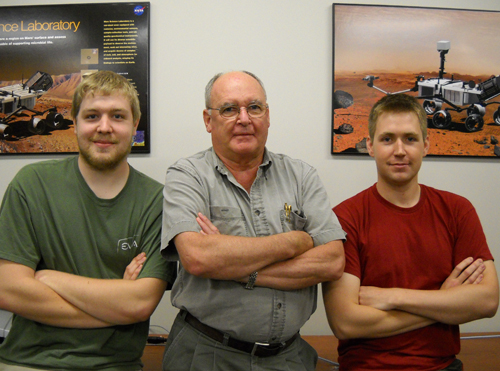
A new Mars rover, complete with a U of G-tested instrument, is orbiting closer to the red planet this summer. To follow some of the action and learn more about Guelph’s ongoing connection to interplanetary exploration, check an eye-catching display in the MacNaughton Building lobby.
The display is just around the corner from a new U of G operations centre that will help lead the rover’s search for signs of past or present life on Mars. The Guelph facility will be the only Canadian operations centre – and one of only a few outside the United States – for the Curiosity rover mission set to begin on Mars in 2012.
“We are the ‘keepers’ of the APXS,” says Nick Boyd, research associate in the Department of Physics. That’s the alpha particle X-ray spectrometer, an instrument mounted on the rover’s robotic arm to examine rocks and soil.
In 2008, that soup-can-sized device spent about three weeks at Guelph for testing by a team led by physics professor Ralf Gellert. It was then assembled on the rover at NASA’s Jet Propulsion Laboratory (JPL) in Pasadena, California.
Earlier this summer, the rover was flown to the Kennedy Space Centre in Florida. It will be launched in late November or early December, and will land on Mars in August 2012.
The vehicle, formally called the Mars Science Laboratory (MSL), will spend about two years exploring Earth’s nearest planetary neighbor. During the mission, Guelph’s operations centre will serve as a conduit between the rover, the JPL and numerous scientists worldwide, helping to guide the rover’s APXS explorations.
Says Boyd: “We will participate in defining the science objectives for any given day on Mars. If scientists require measurements by the instrument, that request will come to our team. We’ll assemble the command sequence to perform that measurement and send that to JPL to be integrated into the rover plan for the day. We will take part in web conferences and teleconferences and work with scientists at JPL.”
Boyd completed a physics degree at Guelph and is now a part-time master’s student in the School of Engineering.
Gellert is principal investigator for an international group of scientists who developed the instrument for the MSL mission. He was the lead scientist for APXS systems used on twin NASA rovers launched in 2003. Those earlier instruments detected evidence that water had been on Mars and that bound water still exists there.
Gellert’s lab still houses a clean room built to test the Curiosity-borne device in 2008. His team will keep a copy of the APXS there for testing and calibration during the actual mission.
Besides Boyd and Gellert, the operations centre group includes:
- Mike Curry, major projects manager in the physics department and a former aerospace scientist, who has worked on instrumentation systems for the International Space Station;
- Will Klumpenhouwer, a third-year physics student who assembled the MacNaughton display and is completing a departmental website about the rover and its instrument;
- Glynis Perrett, a physics PhD student who helped to calibrate the APXS. She will study elements in Martian rock and soil, working with Iain Campbell, University professor emeritus.
Funding for the operations centre came from the Canadian Space Agency. An official opening will take place this fall.
Guelph’s connection to the pending mission is discussed in the MacNaughton display, which includes a slide show about Mars science and a rover’s-eye animation of the red planet.
About the size of a small car, Curiosity is about twice as long and five times as heavy as the earlier Mars rovers, Spirit and Opportunity. It can roll over thigh-high obstacles and travel about the length of two football fields in a day.